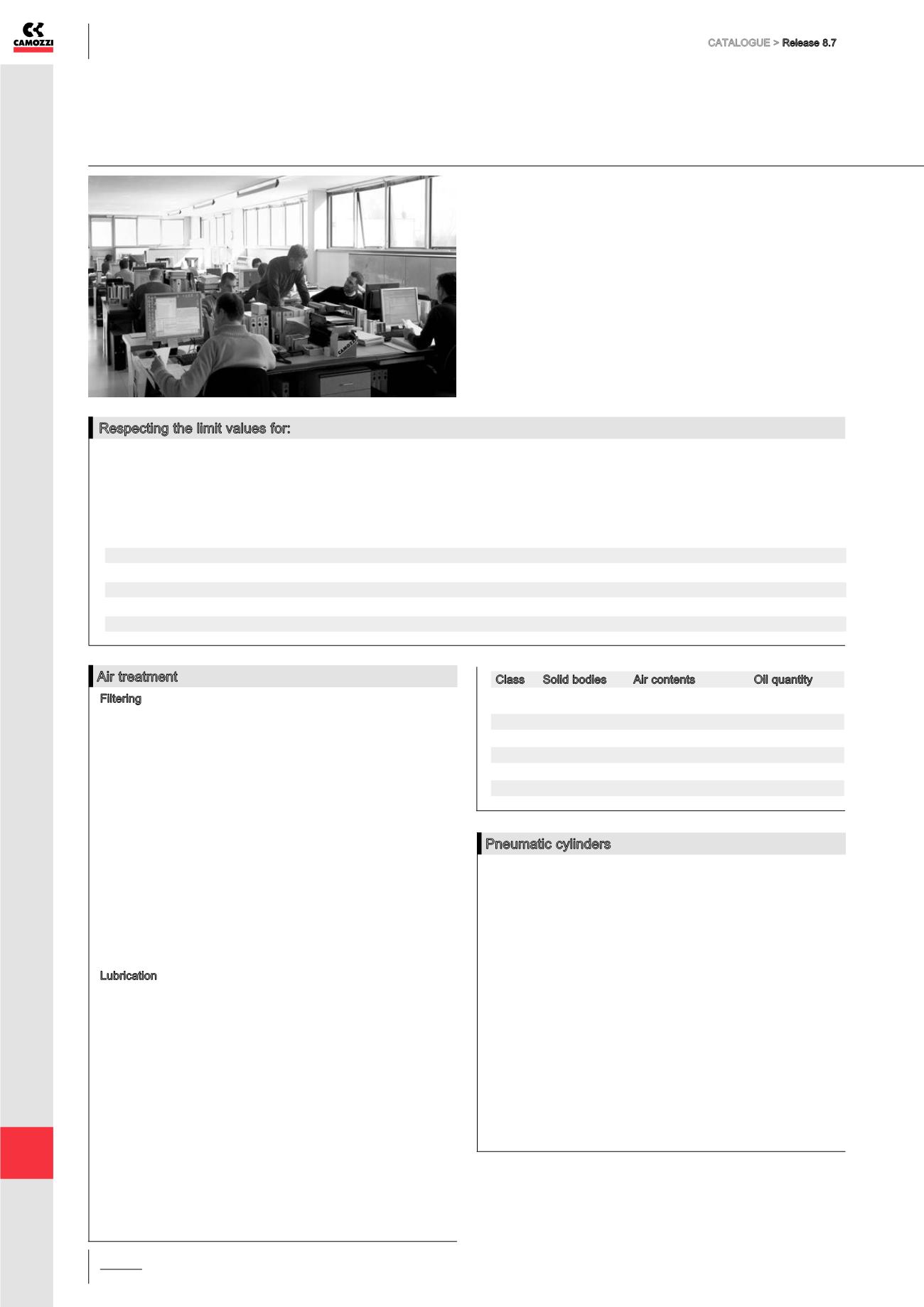

CATALOGUE >
Release 8.7
APPENDIX >
Camozzi products
Information for the use of Camozzi products
a
APPENDIX
Just browsing through the pages of our website
www.camozzi.com,you will have the possibility to
download GSD files for the configuration of Valve
Islands, all relative use and installation manuals
and the configuration software of the product codes.
Moreover, here you can find all 2D and 3D files
in the most commonly used formats.
Air treatment
Filtering
The temperature affects the capacity of air to maintain water particles
(relative humidity).
Warm air contains a larger quantity of water than the same volume
filled with cold air.
An excess of humidity causes the formation of condensate.
Cooling of the air modifies the structure of the water it contains,
by turning it from a gaseous to a liquid state.
Specific apparatus can be used to cool (refrigerator) and heat (drier)
the air and are, as a rule, assembled on the outlet of the compressor.
The filtering elements mounted inside the filters for compressed air,
are only partly able to separate the condensate from the air, in fact,
their main function is to eliminate any solid particles.
During the production of compressed air, compressors can introduce
oil into the distribution network. The characteristics of this oil are not
compatible with the seals of pneumatic components.
The market trend towards miniaturized products imposes the
requirement to use coalescing filters.
It is advisable to provide for automatic drains on the filters.
Lubrication
This is not necessary as the components are already greased with
special products. Only use oils with a viscosity of 32 cSt at 40°C.
The oil quantity has to be a maximum of 1 drop per minute, this
regulation has to be made with the machine in normal operation.
The lubrication, once applied, must never be interrupted. If not,
the seals of the components could degenerate, compromising their
function.
For a correct use of our products, refer to the values shown in the
table of the Air Quality classes according to the Standard DIN ISO
8573-1.
Class Solid bodies Air contents
Oil quantity
Max. dimension dew-point
Max
of the particles
concentration
1
0,1 µ
-70 °C
0,01 mg/m
3
2
1 µ
-40 °C
0,1 mg/m
3
3
5 µ
-20 °C
1 mg/m
3
4
15 µ
+3 °C
5 mg/m
3
5
40 µ
+7 °C
25 mg/m
3
Pneumatic cylinders
The choice of the correct cylinder mounting to the structure
and also that of the rod attachment to any moving parts, are as
important as the control of parameters relating to speed, mass and
radial loads. The control of these parameters has to be guaranteed
by the user. The location of position sensors (reed switches),
and their switching response times to magnetic fields, is dependant
upon the type and bore size of cylinder and the appropriate
precautions need to be taken when fixing these items.
(see notes on the pages relative to the sensors).
We do not advise the use of a cylinder application as a shock
absorber or as pneumatic cushioning. If used at the maximum
speed, we recommend gradual deceleration to avoid a violent impact
between piston and the cylinder end cover.
As a general value, we calculate a maximum average speed of
1 m/sec. In this case no lubrication is required as the lubrication
introduced during assembly is sufficient to guarantee good operation.
If faster speeds are required, we suggest lubrication in the
quantities described above.
Respecting the limit values for:
• Pressure
• Speed
• Mass
• Voltage
• Actuating force
• Temperature
The pneumatic components have to be used with properly prepared compressed air. The type of preparation depends on the environmental
characteristics and the sector of industry in which they will be used. Except for different imformation shown on the technical data sheet for the
single products, in general the air characteristics should be:
Fluid temperature:
-10 ÷ +60°
Environmental temperature:
-20 ÷ +80°
Air filtering according to DIN ISO 8573-1:
not superior to the classes 5/5/4 (see table)
Lubrication:
not necessary, in case use ISOVG32 oil and do not interrupt the lubrication once applied.
Oil contents:
From 1 to 5 drops every 1000 litres of air
a
/2.01
01



















